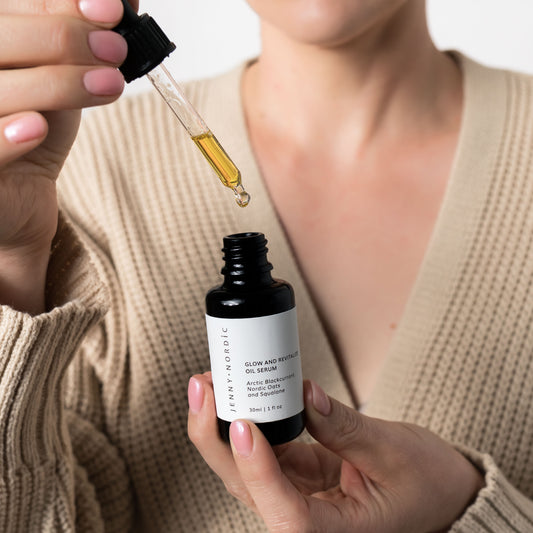
Minimal Skincare - 40s Edition
Share
Ageing is such a privilege and we don’t believe many of us want to be any younger than we actually are. Age brings confidence to make your own choices, acceptance and forgiveness towards yourself and others.
Some things we probably would like to skip though - if possible. One is the changes in our skin that ageing brings along. Especially the ones that are induced by our changing hormones.
How to take care of your skin in your 40s is such a minefield of contracting advice that we thought to break it down for you.

Hormonal changes in your 40s and how they affect the skin
Let’s start from the very basics. What are hormones? Hormones affect the whole human body. They are a big deal and are used to communicate between organs and tissues. They, for example, stimulate or inhibit growth, regulate metabolism and activate the immune system.
Our hormones change throughout our lives and fluctuate monthly through the period cycle. Some studies have shown that oestrogen plays a huge role in the skin ageing process. This explains the changes our skin goes through in our 40s, the period that we call perimenopause. Read more about how to support your skin through perimenopause here.
Oestrogen has significant jobs and responsibilities when it comes to our skin. As the oestrogen levels start lowering at a more rapid speed, our epidermis, and the outer layer of our skin get thinner. Oestrogen also plays a vital role in keeping our skin hydrated and our skin barrier functioning well. Exercise can help maintain and balance fluctuating hormones during perimenopause.
Read what movement PT Anna Black recommends for women in their 40s and beyond.
Learn how to treat dull and dehydrated skin here.
Decreasing oestrogen shows on our skin as deeper wrinkles, reduced firmness and elasticity and increased photoaging, i.e. the damage sun does to the skin. Within the dermis, the skin layer beneath the epidermis, decreasing oestrogen causes reduced collagen and hyaluronic acid production and reduced fibroblast activity.
Fibroblasts are important as they contribute to the formation of connective tissue, a fibrous cellular material that supports and connects other tissues or organs in the body. Fibroblasts secrete collagen proteins that help maintain the structural framework of tissues.
These skin changes that lower levels of oestrogen are bringing along doesn’t sound that intriguing, right? So what can we do to help our skin and bodies go through the changes and fluctuations and maintain that beautiful glow?
Read our blog on can you slow down ageing here.
Skincare routine in your 40s
With topical skincare, we can influence positively some of the changes and delay some. It all comes down to the strength of the skin barrier function and the health of the skin.
What to look for in your skincare product in your 40s?

Anti-inflammatory agents - Inflammation is thought to play an important role in the process of dermal ageing as it can cause a breakdown of connective tissue components - collagen and elastin. By preventing or reducing inflammation in the skin, you can prevent further deterioration of connective tissue. Some well-known anti-inflammatory ingredients are bisabolol, calendula, lavender, niacinamide and oats.
Antioxidants - Antioxidants are ingredients that can help the body eliminate or fight the effects of free radicals. Once antioxidants have access to free radicals in the skin, they can neutralise them and prevent the chain of free radical damage from continuing. Applying an antioxidant will help to prevent a loss of firmness and elasticity and help to prevent wrinkles. The key word here is to prevent – an antioxidant cannot repair the damage that has already occurred.
Ceramides - The outermost layer of the skin, the stratum corneum, is composed mainly of ceramides. The number of ceramides decreases as we age and that can lead to transepidermal water loss (TEWL).
Fatty Acids - Botanical seed oils are an excellent source of both lipids and Essential Fatty Acids. The topical application of EFAs can increase cell membrane fluidity, enhance skin barrier function and improve skin moisture levels, just to name a few.
Moisturising agent - While emollients, such as plant oils, soften and smooth the skin, hydrators help to conserve water in the skin. Using a moisturising agent such as face oil or moisturiser in your skincare regularly increases the skin’s moisturise content and barrier function strength.
Peptides - Peptides are amino acids that make up certain proteins needed by the skin. They are the building blocks of collagen and elastin in the skin. As peptides boost collagen and elastin production in the skin, it can help firm the skin and smooth out fine lines and wrinkles.
Vitamins - While vitamins A, C and E help prevent loss of firmness and elasticity in the skin, vitamin B3 can improve barrier function and help treat age-related pigmentation.
The Balance & Glow Ritual is designed to balance and nourish your skin. It's available also in travel size so that you can safely test out the products if you are new to Jenny Nordic Skincare.

Essential skincare products
What kind of skincare products you then should be looking for with these ingredients? It all depends on how many products you want to layer on your skin. We know some swear by single-ingredient products and boosters and love to pamper themselves with a 9-step skincare ritual.
The other option is to strip it back, go back to basics and use just a few multifunctional products. A gentle cleanser that doesn’t dry or disturb the skin, a mist or essence and a moisturiser or oil serum that together contains all the essentials for the skin to glow and radiate.
We are team minimal skincare for sure, which one are you?
Read how to build a skincare routine that works here.
For daily skincare tips and inspiration, follow us on Instagram!










